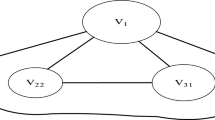Abstract
A triangle in a triple system is a collection of three edges isomorphic to {123,124,345}. A triple system is triangle-free if it contains no three edges forming a triangle. It is tripartite if it has a vertex partition into three parts such that every edge has exactly one point in each part. It is easy to see that every tripartite triple system is triangle-free. We prove that almost all triangle-free triple systems with vertex set [n] are tripartite.
Our proof uses the hypergraph regularity lemma of Frankl and Rödl [13], and a stability theorem for triangle-free triple systems due to Keevash and the second author [15].
Similar content being viewed by others
References
J. Balogh, B. Bollobás and M. Simonovits: On the number of graphs without Forbidden subgraph, J. Combin. Theory Ser. B 91 (2004), 1–24.
J. Balogh, B. Bollobás and M. Simonovits: The typical structure of graphs without given excluded subgraphs, Random Structures and Algorithms 34 (2009), 305–318.
J. Balogh, B. Bollobás and M. Simonovits: The fine structure of octahedron-free graphs, J. Combin. Theory, Ser. B 101(2) (2011), 67–84.
J. Balogh and J. Butterfield: Excluding induced subgraphs: Critical graphs; Random Structures and Algorithms 38(1–2) (2011), 100–120.
J. Balogh and D. Mubayi: Almost all triple systems with independent neighborhoods are semi-bipartite, J. Combin. Theory, Ser. A 118(4) (2011), 1494–1518.
J. Balogh and W. Samotij: The number of Ks,t-free graphs, Journal of the London Mathematical Society 83 (2011), 368–388.
B. Bollobás: Three-graphs without two triples whose symmetric difference is contained in a third, Discrete Math. 8 (1974), 21–24.
B. Bollobás and A. Thomason: Projections of bodies and hereditary properties of hypergraphs, Bull. London Math. Soc. 27 (1995), 417–424.
R. Dotson and N. Brendan: Hereditary properties of hypergraphs, J. Combin. Theory, Ser. B 99 (2009), 460–473.
P. Erdős, P. Frankl and V. Rödl: The asymptotic number of graphs not containing a fixed subgraph and a problem for hypergraphs having no exponent, Graphs and Combin. 2 (1986), 113–121.
P. Erdős, D. J. Kleitman and B. L. Rothschild: Asymptotic enumeration of K n-free graphs, in Colloquio Internazionale sulle Teorie Combinatorie (Rome, 1973), Vol. II, 19–27. Atti dei Convegni Lincei, 17, Accad. Naz. Lincei, Rome, 1976.
P. Frankl and Z. Füredi: A new generalization of the Erdős-Ko-Rado theorem, Combinatorica 3(3–4) (1983), 341–349.
P. Frankl and V. Rödl: Extremal problems on set systems, Random Structures and Algorithms 20(2) (2002), 131–164.
Z. Füredi and M. Simonovits: Triple systems not containing a Fano configuration, Combinatorics, Probabality and Computing 14 (2005), 467–484.
P. Keevash and D. Mubayi: Stability results for cancellative hypergraphs, J. Combin. Theory, Ser. B 92 (2004), 163–175.
P. Keevash and B. Sudakov: The Turán number of the Fano plane, Combinatorica 25(5) (2005), 561–574.
Y. Kohayakawa, B. Nagle, V. Rödl and M. Schacht: Weak hypergraph regularity and linear hypergraphs, J. Combin. Theory, Ser. B 100(2) (2010), 151–160.
Ph. G. Kolaitis, H. J. Prömel and B. L. Rothschild: K l+1-free graphs: asymptotic structure and a 0-1 law, Trans. Amer. Math. Soc. 303 (1987), 637–671.
B. Nagle and V. Rödl: The asymptotic number of 3-graphs not containing a fixed one, Discrete Math. 235 (2001), 271–290.
B. Nagle, V. Rödl and M. Schacht: Extremal hypergraph problems and the regularity method, Topics in Discrete Mathematics, Algorithms Combin. vol. 26, Springer, Berlin (2006), 247–278.
Y. Person and M. Schacht: Almost all hypergraphs without Fano planes are bipartite, in: Proceedings of the Twentieth Annual ACM-SIAM Symposium on Discrete Algorithms (C. Mathieu, ed.), (SODA 09), 217–226. ACM Press.
H. J. Prömel and A. Steger: The asymptotic number of graphs not containing a fixed color-critical subgraph, Combinatorica 12(4) (1992), 463–473.
Author information
Authors and Affiliations
Corresponding author
Additional information
Research supported in part by NSF CAREER Grant DMS-0745185 and DMS-0600303, UIUC Campus Research Board Grants 09072 and 08086, and OTKA Grant K76099.
Research supported in part by NSF grants DMS 0653946 and 0969092.
Rights and permissions
About this article
Cite this article
Balogh, J., Mubayi, D. Almost all triangle-free triple systems are tripartite. Combinatorica 32, 143–169 (2012). https://doi.org/10.1007/s00493-012-2657-4
Received:
Published:
Issue Date:
DOI: https://doi.org/10.1007/s00493-012-2657-4




